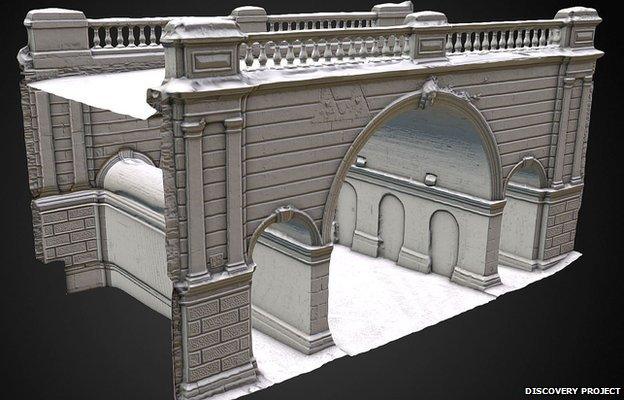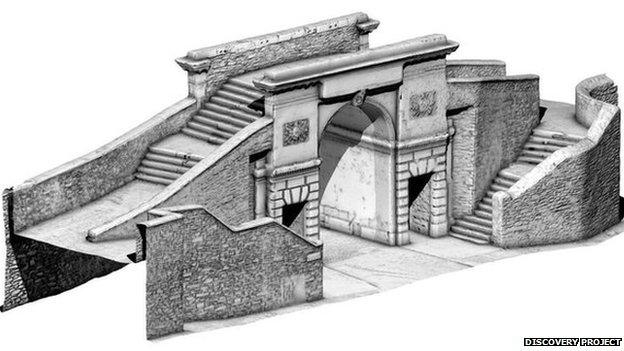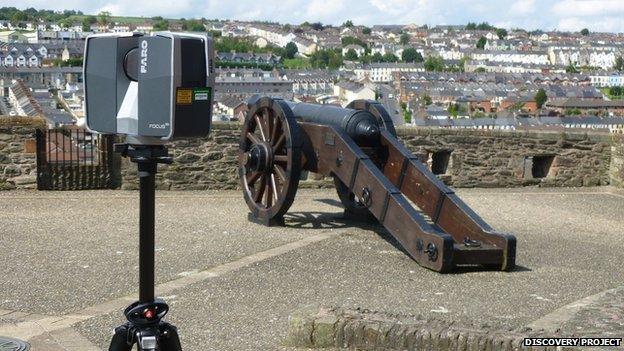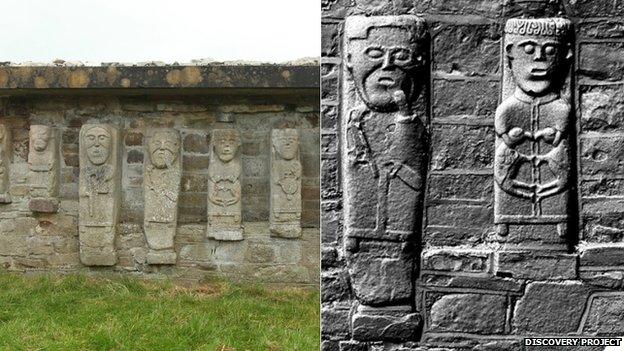Derry's walls among Irish history sites recreated in 3D models
- Published

Ferryquay Gate is located on the site of one of the four original gates in Derry
Londonderry's historic walls have been painstakingly recreated in a 3D model as part of a new Irish history project.
The 17th Century walls, which form a walkway around the city, were scanned to produce detailed images and videos.
Medieval sculptures at White Island on Lower Lough Erne in County Fermanagh and Navan Fort in County Armagh were also recreated as part of the project, external.
The work has been carried out by the Dublin-based Discovery Programme, which researches Irish archaeology.
Precision

The 3D laser scanners recorded the detail on the walls to a precision of 1cm
Derry's walls were built between 1613 and 1618 by the Honourable Irish Society as defences for settlers from England and Scotland.
They are Northern Ireland's largest state monument and, as the last walled city to be built in Europe, many argue that the Maiden City's barricades are the most complete and spectacular.
The 3D models that have been created will be of use for gaming, TV and films, as well as for providing imaging for exhibitions and websites.
Rob Shaw, a geo-surveyor on the project, said the full 1.5km circuit of the walls was scanned to a precision of 1cm.
And working on the walls was made all the more challenging because, unlike most of the other sites that were recorded, they are based right in the heart of a bustling city.
Modelling
"We surveyed the walls using a terrestrial laser scanner and carried out the work over three visits, and a total of three solid weeks," he said.
"You do leave yourself a target for curiosity - people wonder what you're doing - and traffic coming through the gates made it difficult, too."

Bishop's Gate was one of the four original entrances to the city
But the work did not finish there.
Typically, one day in the field is followed by three days of modelling using the software that creates the final images.
Fragile
"There is an engineering purpose for recording the walls, too," Mr Shaw said.
"If the walls were to get damaged in any way - say if a truck hit part of one of the gates - we have a record of the walls for engineers so they can use that as a basis for carrying out repairs.
"Heritage can be very fragile, precious monuments can be very fragile, and that is one of the reasons why we've done this."
The three-year EU co-funded project is documenting UNESCO World Heritage monuments and other monuments of outstanding value.
The monastery at Skellig Michael in County Kerry, the passage tomb at Newgrange in County Meath and the Pulnabrone dolmen in County Clare are among the ancient structures in the Republic of Ireland that have been scanned and recreated using the cutting edge 3D technology.
Visit
The models have already been used by teachers in history lessons across Ireland and Mr Shaw says they also offer benefits to the tourism sector.
"Ireland's big tag-line in tourism terms is based on its heritage," he said.

The Discovery Project spent three weeks scanning on Derry's walls
"People come to see the walls and the gates, or any of the other monuments and buildings, on the website, and it could spur them to make a visit."
Mr Shaw said he was now keen for the project to cover more sites in Northern Ireland.
"This has been a pilot programme in its first phase and we'd like to do a lot more.
"We haven't got a definitive list, but we would be interested in going down a thematic route, looking at early Christian carvings or high crosses.

Medieval sculptures at White Island on Lower Lough Erne have also been recreated in 3D
"Many of the places we visited are places you know about as a child, and so to be given a key to them and left there to discover them was a real privilege."